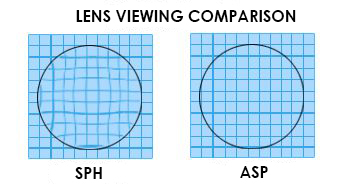
In the realm of optical innovation, lens design is primarily categorized into two types: spherical and aspheric. Aspheric lenses, driven by the pursuit of slimness, necessitate a transformation in the lens curvature, diverging significantly from the traditional spherical lens surface curvature. The spherical design, previously commonplace, was plagued by increased aberrations and distortions. This often resulted in pronounced issues such as blurred images, warped vision, and a limited field of view.
Now, the aspheric design has emerged as a corrective force, addressing these visual distortions effectively and providing a solution that offers lenses that are not only lighter and thinner but also uniformly flat. Importantly, these advancements do not compromise the lenses’ outstanding impact resistance, ensuring a safe wearing experience.
Traditional spherical lenses have a notable downside – objects viewed around the periphery of the lens appear distorted, constricting the wearer's field of view. In an age where technology continuously evolves, aspheric lenses – a true optical marvel – minimize aberrations at the lens edge, significantly broadening the field of view to meet customer demands. Aspheric lenses feature a flatter base curve and are lighter, enhancing the natural and aesthetic appeal. Especially in cases of high refractive power, they adeptly reduce eye distortion, making them an ideal choice for consumers with higher prescription needs.

The defining feature of aspheric lenses is their unique surface curvature. This aspheric design offers several advantages over traditional spherical lenses:
1.Clarity: Treated with a specialized coating process, aspheric lenses provide exemplary visual performance, ensuring a clear and comfortable viewing experience.
2.Comfort: So light they are almost imperceptible, aspheric lenses reduce the 'weight' on your eyes, allowing for a relaxed and effortless wear.
3.Natural Vision: Their aspheric design minimizes visual distortion, leading to a more realistic and accurate perception.
Comparing spherical and aspheric lenses of identical material and prescription, aspheric lenses stand out as flatter, thinner, and provide more realistic and comfortable viewing experiences. Observing the coating shape of a lens against a light source reveals that reflections from spherical lenses are generally straighter (except in high refractive power lenses); aspheric lenses, however, display greater curvature due to varying curvatures across their surface.
The peripheral edges of traditional spherical lenses not only appear thicker but also distort and twist the view of objects, a phenomenon known as image aberration. To achieve a lightweight design, high refractive index materials have been employed in lens manufacturing. Moreover, when viewed through spherical lenses, the wearer's facial contours are noticeably distorted. Aspheric lenses, in contrast, reduce both the center and edge thickness, resulting in a slimmer lens that eliminates peripheral aberrations, thus offering a natural visual experience.
Aspheric lenses provide a broad and uncurved field of view at the edges, with minimal image aberration, rendering the images exceptionally natural. These lenses are three times harder than their spherical counterparts, making them particularly suitable for young wearers. With the same -5.00DS prescription, aspheric lenses are 26% lighter than spherical lenses. Their flatter surface ensures a natural, undistorted view of the world, both near and far, reducing eye fatigue over extended periods.
Ideal for first-time eyeglass wearers, especially students and office workers, aspheric lenses significantly alleviate initial discomfort associated with wearing glasses. They are also an excellent alternative for contact lens users, serving as backup eyewear at home. Aspheric lenses closely mimic natural vision, akin to the experience with contact lenses. They are perfect for those who prefer to downplay their high prescription, wish to avoid the appearance of smaller eyes with myopia glasses, seek to lighten the weight of their lenses, or have different refractive needs for each eye.
Aspheric lenses can give medium refractive index lenses the same slim and flat appearance as high refractive index lenses, minimizing edge aberrations and catering to a wide field of view that satisfies all customer needs.


Post time: Jan-04-2024





